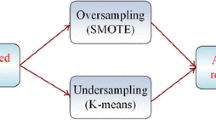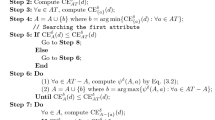Abstract
Though attribute reduction defined by neighborhood decision error rate can improve the classification performance of neighborhood classifier via deleting redundant attributes, such reduction does not take the variations of classification results into account. To fill this gap, a multi-criterion based attribute reduction is proposed, which considers both neighborhood decision error rate and neighborhood decision consistency. The neighborhood decision consistency is used to measure the variations of classification results if attributes change. Following the novel attribute reduction, a heuristic algorithm is also designed to derive reduct which aims to obtain less error rate and higher consistency simultaneously. The experimental results on 10 UCI data sets show that the multi-criterion based reduction can not only improve the decision consistencies without decreasing the classification accuracies significantly, but also bring us more stable reducts. This study suggests new trends concerning criteria and constraints in attribute reduction.




Similar content being viewed by others
References
Azam N, Yao JT (2014) Game-theoretic rough sets for recommender systems. Knowl Based Syst 72:96–107
Chen HM, Li TR, Luo C, Wang GY (2015) A decision-theoretic rough set approach for dynamic data mining. IEEE Trans Fuzzy Syst 23:1–14
Chen Y (2016) An adjustable multigranulation fuzzy rough set. Int J Mach Learn Cybern 7:1–8
Cheng Y (2017) Dynamic maintenance of approximations under fuzzy rough sets. Int J Mach Learn Cybern. https://doi.org/10.1007/s13042-017-0683-7
Dash M, Liu H (2003) Consistency-based search in feature selection. Artif Intell 151:155–176
Daoud EA (2015) An efficient algorithm for finding a fuzzy rough set reduct using an improved harmony search. Int J Modern Educ Comput Sci 7:16–23
Dou HL, Yang XB, Song XN, Yu HL, Wu WZ (2016) Decision-theoretic rough set: a multicost strategy. Knowl Based Syst 91:71–83
Guo YW, Jiao LC, Wang S, Wang S, Liu F, Rong KX, Xiong T (2014) A novel dynamic rough subspace based selective ensemble. Pattern Recognit 48:1638–1652
Hu QH, Pedrycz W, Yu DR, Liang J (2010) Selecting discrete and continuous features based on neighborhood decision error minimization. IEEE Trans Syst Man Cybern Part B (Cybernetics). 40:137–150
Hu QH, Yu DR, Xie ZX (2008) Neighborhood classifiers. Expert Syst Appl 34:866–876
Hu QH, Yu DR, Xie ZX, Li XD (2007) EROS: ensemble rough subspaces. Pattern Recognit 40:3728–3739
Ju HR, Li HX, Yang XB, Huang B (2017) Cost-sensitive rough set: a multi-granulation approach. Knowl Based Syst 123:137–153
Ju HR, Yang XB, Yu H, Li TJ, Yu DJ, Yang JY (2016) Cost-sensitive rough set approach. Inf Sci 355–356:282–298
Ju HR, Yang XB, Song XN (2014) Dynamic updating multigranulation fuzzy rough set: approximations and reducts. Int J Mach Learn Cybern 5:981–990
Korytkowski M, Rutkowski L, Scherer R (2015) Fast image classification by boosting fuzzy classifiers. Inf Sci 327:175–182
Kuncheva L, Whitaker CJ (2003) Measures of diversity in classifier ensembles and their relationship with the ensemble accuracy. Mach Learn 51:181–207
Li JH, Kumar CA, Mei CL, Wang XZ (2017) Comparison of reduction in formal decision contexts. Int J Approx Reason 80:100–122
Li SQ, Harner EJ, Adjeroh DA (2011) Random KNN feature selection-a fast and stable alternative to random forests. BMC Bioinf 12:1–11
Mi JS, Wu WZ, Zhang WX (2004) Approaches to knowledge reduction based on variable precision rough set model. Inf Sci 159:255–272
Min F, He HP, Qian YH, Zhu W (2011) Test-cost-sensitive attribute reduction. Inf Sci 181:4928–4942
Pawlak Z (1982) Rough sets. Int J Comput Inf Sci 11:342–356
Qian YH, Liang JY, Pedrycz W, Dang CY (2010) Positive approximation: an accelerator for attribute reduction in rough set theory. Artif Intell 174:597–618
Sneath P, Sokal R (1975) Numerical taxonomy. J Geol 193:855–860
Sim J, Wright CC (2005) The kappa statistic in reliability studies: use, interpretation, and sample size requirements. Phys Ther 85:257–268
Skalak DB (1996) The sources of increased accuracy for two proposed boosting algorithms. American Association for Artificial Intelligence, Integrating Multiple Learned MODELS Workshop 120–125
Tohka J, Moradi E, Huttunen H (2016) Comparison of feature selection techniques in machine learning for anatomical brain MRI in dementia. Neuroinformatics. 14:1–18
Tsang ECC, Hu QH, Chen DG (2016) Feature and instance reduction for PNN classifiers based on fuzzy rough sets. Int J Mach Learn Cybern 7:1–11
Wang CZ, Qi YL, Shao MW, Hu QH, Qian YH, Chen DG, Lin YJ (2016) A fitting model for feature selection with fuzzy rough sets. IEEE Transactions on Fuzzy Systems. https://doi.org/10.1109/TFUZZ.2016.2574918
Wang CZ, Shao MW, He Q, Qian YH, Qi YL (2016) Feature subset selection based on fuzzy neighborhood rough sets. Knowl Based Syst 111:173–179
Wang CZ, Hu QH, Wang XZ, Chen DG, Qian YH (2017) Feature selection based on neighborhood discrimination index. IEEE Transactions on Neural Networks and Learning Systems. https://doi.org/10.1109/TNNLS.2017.2710422
Wang H, Jing XJ, Niu B (2017) A discrete bacterial algorithm for feature selection in classification of microarray gene expression cancer data. Knowl Based Syst 126:8–19
Wang H, Niu B (2017) A novel bacterial algorithm with randomness control for feature selection in classification. Neurocomputing 228:176–186
Xu SP, Yang XB, Yu HL, Tsang ECC (2016) Multi-label learning with label-specific feature reduction. Knowl Based Syst 104:52–61
Xu J, Xie SL, Zhu WK (2017) Marginal patch alignment for dimensionality reduction. Soft Comput 21:2347–2356
Xu J, Gu ZH, Xie K (2016) Fuzzy local mean discriminant analysis for dimensionality reduction. Neural Process Lett 44:701–718
Yang XB, Qi Y, Yu HL, Yang JY (2014) Updating multigranulation rough approximations with increasing of granular structures. Knowl Based Syst 64:59–69
Yang XB, Zhang M, Dou HL, Yang JY (2011) Neighborhood systems-based rough sets in incomplete information system. Knowl Based Syst 24:858–867
Yao YY, Zhang XY (2017) Class-specific attribute reducts in rough set theory. Inf Sci 418:601–618
Yule GU (1900) On the association of attributes in statistics. Philos Trans R Soc A: Math Phys Eng Sci 194:257–319
Zhai JH, Zhang SF, Wang CX (2017) The classification of imbalanced large data sets based on MapReduce and ensemble of ELM classifiers. Int J Mach Learn Cybern 8:1009–1017
Zhao H, Wang P, Hu QH (2016) Cost-sensitive feature selection based on adaptive neighborhood granularity with multi-level confidence. Inf Sci 366:134–149
Zhang X, Mei CL, Chen DG, Li JH (2016) Feature selection in mixed data: a method using a novel fuzzy rough set-based information entropy. Pattern Recognit 56:1–15
Acknowledgements
This work is supported by the Natural Science Foundation of China (Nos. 61572242, 61503160, 61772273, 61502211, 61471182), Qing Lan Project of Jiangsu Province of China.
Author information
Authors and Affiliations
Corresponding author
Rights and permissions
About this article
Cite this article
Li, J., Yang, X., Song, X. et al. Neighborhood attribute reduction: a multi-criterion approach. Int. J. Mach. Learn. & Cyber. 10, 731–742 (2019). https://doi.org/10.1007/s13042-017-0758-5
Received:
Accepted:
Published:
Issue Date:
DOI: https://doi.org/10.1007/s13042-017-0758-5




